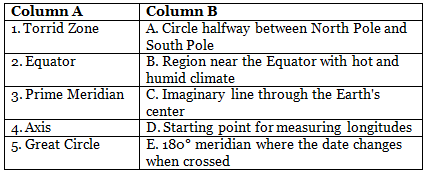Worksheet Solutions: A Globe, Latitudes and Longitudes | Footprints Class 6: Book Solutions, Notes & Worksheets PDF Download
Q1: Multiple Choice Questions (MCQs)
(i) The Earth's axis is:
(a) an imaginary line that horizontally divides the Earth.
(b) an angular line that runs across the Tropic of Cancer.
(c) an imaginary line on which the Earth rotates.
Ans: (c)
The Earth's axis is an imaginary line passing through its center, on which the Earth rotates.
(ii) The Equator is also known as the:
(a) Great Circle.
(b) Meridian.
(c) Ante meridian.
Ans: (a)
The Equator is also referred to as the Great Circle.
(iii) The Equator divides the Earth into the:
(a) Northern Hemisphere and the Southern Hemisphere.
(b) Eastern Hemisphere and the Western Hemisphere.
(c) North Pole and the South Pole.
Ans: (a)
The Equator splits the Earth into the Northern Hemisphere and the Southern Hemisphere.
(iv) The heat zone in which the Equator falls is the:
(a) Temperate Zone.
(b) Torrid Zone.
(c) Frigid Zone.
Ans: (b)
The Equator is located in the Torrid Zone, which is known for its hot and humid climate.
(v) The longitude that determines the Indian Standard Time is:
(a) 0°.
(b) 180°.
(c) 82°30'E.
Ans: (c)
The longitude 82°30'E, near Prayagraj in India, determines the Indian Standard Time (IST).
Q2: Fill in the Blanks
(i) Latitude is the angular distance of a place, north or south of the _______________.
Ans: Equator
(ii) The world is divided into ____________ time zones or belts.
Ans: 24
(iii) The Equator represents _____________.
Ans: 0°
(iv) The Prime Meridian passes through _______________ in England.
Ans: Greenwich
(v) Lines of latitude run ____________ to the Equator.
Ans: parallel
Q3: Match the Column (Table)

Ans:
Q4: True or False
(i) All lines of longitude are circles.
Ans: False.
Lines of longitude are straight lines running from the North Pole to the South Pole.
(ii) The Temperate Zone is the hottest zone.
Ans: False.
The Torrid Zone, near the Equator, is the hottest zone.
(iii) 'Geoid' is the term used to describe the shape of the Earth.
Ans: True.
Geoid refers to the Earth's slightly flattened and bulging shape.
(iv) The world is divided into 28 time zones.
Ans: False.
The world is divided into 24 time zones.
(v) The Antarctic Circle lies in the Northern Hemisphere.
Ans: False.
The Antarctic Circle lies in the Southern Hemisphere.
|
65 videos|125 docs|25 tests
|
FAQs on Worksheet Solutions: A Globe, Latitudes and Longitudes - Footprints Class 6: Book Solutions, Notes & Worksheets
| 1. What is a globe and why is it used? |  |
| 2. What are latitudes and longitudes? |  |
| 3. How do latitudes and longitudes help in navigation? |  |
| 4. What is the significance of the equator in latitudes? |  |
| 5. How are latitudes and longitudes helpful in understanding climate patterns? |  |





















